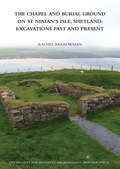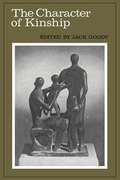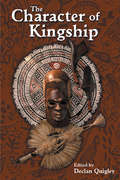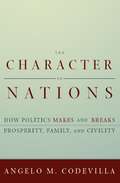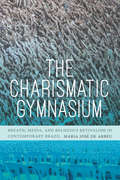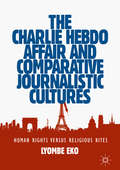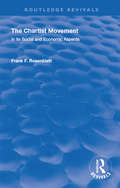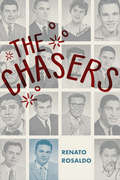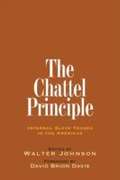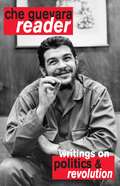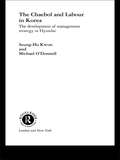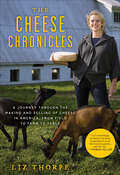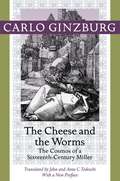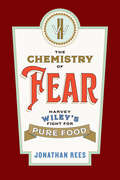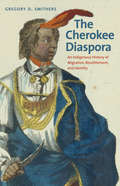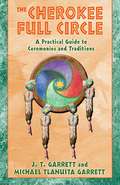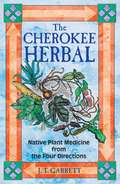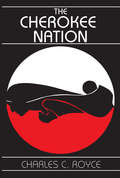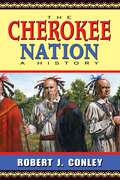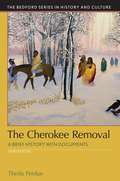- Table View
- List View
The Chapel and Burial Ground on St Ninian's Isle, Shetland: Excavations Past and Present (The Society for Medieval Archaeology Monographs)
by Rachel C. Barrowman"This volume is the definitive account of the excavation which led to the discovery of the magnificent hoard of 28 pieces of Pictish silverware on St Ninian's Isle, Shetland in 1958. It includes a reassessment of the original archives and finds, including an ogham stone found on the site in 1876 and a fantastic collection of glass beads, as well as several new small-scale excavations on the site of the chapel and its burial ground. Taken together, this work reveals a long sequence of settlement beginning in the Iron Age. The first church was built on the site in the 8th century, and accompanied by a long cist cemetery with cross-incised stones and shrine sculpture. The church may have continued in use into the 9th or 10th centuries, and the recent work has confirmed that the famous hoard was buried into its floor. There was a degree of continuity between the pre-Christian and Christian burials, with evidence that the site was a special place for burial before the advent of Christianity. The report describes these burials in detail, ending the story sometime between the 11th and end of the 12th centuries, when an adult male who had died a violent death was moved to be buried on the site. Thereafter the site was inundated with wind-blown sand. A new chapel with an accompanying long cist cemetery was then built above the earlier church, and a chancel was added later. The associated graveyard continued in use until around 1840, long after the building was demolished."
The Character Of Kinship
by Jack GoodyA collection of specially commissioned essays dealing with general aspects of kinship, family and marriage from an anthropological point of view, that is, considering the total range of human societies. In his editorial introduction, Jack Goody explains that his aim has been to provide 'essays dealing with general themes rather than ethnographic conundrums or descriptive minutiae' in the hope of achieving 're-consideration of some central problem areas including those examined by an earlier generation of anthropologists and still raised by scholars outside the discipline itself'. Individual essays cover problems such as the nature of kinship and the family; why monogamy?; intermarriage and the creation of castes. The contributors include R. G. Abrahams, J. A. Barnes, Fredrik Barth, Maurice Bloch, Derek Freeman, Jack Goody, Grace Harris, Jean La Fontaine, Edmund Leach, Julian Pitt-Rivers, Raymond T. Smith, Andrew Strathern and S. J. Tambiah.
The Character of Kingship
by Declan QuigleyWhy has monarchy been such a prevalent institution throughout history and in such a diverse range of societies? Kingship is at the heart of both ritual and politics and has major implications for the theory of social and cultural anthropology. Yet, despite the contemporary fascination with royalty, anthropologists have sorely neglected the subject in recent decades. This book combines a strong theoretical argument with a wealth of ethnography from kingships in Africa, Asia and the Pacific. Quigley gives a timely and much-needed overview of the anthropology of kingship and a crucial reassessment of the contributions of Frazer and Hocart to debates about the nature and function of royal ritual. From diverse fieldwork sites, a number of eminent anthropologists demonstrate how ritual and power intertwine to produce a series of variations around myth, tragedy and historical realities. However, underneath this diversity, two common themes invariably emerge: the attempt to portray kingship as timeless and perfect, and the dual nature of the king as sacred being and scapegoat.
The Character of Nations: How Politics Makes and Breaks Prosperity, Family, and Civility
by Angelo M. CodevillaIn this cross-cultural study, Angelo M. Codevilla illustrates that as people shape their governments, they shape themselves. Drawing broadly from the depths of history, from the Roman republic to de Tocqueville’s America, as well as from personal and scholarly observations of the world in the twentieth century, The Character of Nations reveals remarkable truths about the effects of government on a society’s economic arrangements, moral order, sense of family life, and ability to defend itself. Codevilla argues that in present-day America, government has had a profound negative effect on societal norms. It has taught people to seek prosperity through connections with political power; it has fostered the atrophy of civic responsibility; it has waged a Kulturkampf against family and religion; and it has dug a dangerous chasm between those who serve in the military and those who send it in harm’s way. Informative and provocative, The Character of Nations shows how the political decisions we make have higher stakes than simply who wins elections.
The Charisma Machine: The Life, Death, and Legacy of One Laptop per Child (Infrastructures)
by Morgan G. AmesA fascinating examination of technological utopianism and its complicated consequences.In The Charisma Machine, Morgan Ames chronicles the life and legacy of the One Laptop per Child project and explains why—despite its failures—the same utopian visions that inspired OLPC still motivate other projects trying to use technology to “disrupt” education and development. Announced in 2005 by MIT Media Lab cofounder Nicholas Negroponte, One Laptop per Child promised to transform the lives of children across the Global South with a small, sturdy, and cheap laptop computer, powered by a hand crank. In reality, the project fell short in many ways—starting with the hand crank, which never materialized. Yet the project remained charismatic to many who were captivated by its claims of access to educational opportunities previously out of reach. Behind its promises, OLPC, like many technology projects that make similarly grand claims, had a fundamentally flawed vision of who the computer was made for and what role technology should play in learning.Drawing on fifty years of history and a seven-month study of a model OLPC project in Paraguay, Ames reveals that the laptops were not only frustrating to use, easy to break, and hard to repair, they were designed for “technically precocious boys”—idealized younger versions of the developers themselves—rather than the children who were actually using them. The Charisma Machine offers a cautionary tale about the allure of technology hype and the problems that result when utopian dreams drive technology development.
The Charismatic Gymnasium: Breath, Media, and Religious Revivalism in Contemporary Brazil
by Maria José de AbreuIn The Charismatic Gymnasium Maria José de Abreu examines how Charismatic Catholicism in contemporary Brazil produces a new form of total power through a concatenation of the breathing body, theology, and electronic mass media. De Abreu documents a vast religious respiratory program of revival popularly branded as “the aerobics of Jesus.” Pneuma—the Greek term for air, breath, and spirit—is central to this aerobic program, whose goal is to labor on the athletic elasticity of spirit. Tracing the rhetoric, gestures, and spaces that together constitute this new theological community, de Abreu exposes the articulating forces among evangelical Christianity, neoliberal logics, and the rise of right-wing politics. By calling attention to how an ethics of pauperism vitally intersects with the neoliberal ethos of flexibility, de Abreu shows how paradoxes do not hinder but expand the Charismatic gymnasium. The result, de Abreu demonstrates, is the production of a fluid form of totalitarianism and Christianity in Brazil and beyond.
The Charities of London, 1480 - 1660: The aspirations and the achievements of the urban society
by W. K. JordanIn this work, Professor Jordan continues his study of the origins of modern social and cultural institutions in England. He is concerned with the momentous shift which occurred in men's aspirations for their society in the course of the sixteenth and seventeenth centuries, as reflected in the charities which were established by gifts and bequests. This volume deals with the immense contribution made by London to this process of historical change, a change so swift as to be revolutionary in its institutional implications. The author describes the vast charitable system which London created, examines at length the aspirations and the social philosophy of the merchant aristocracy which controlled its affairs, and seeks to assess the social dominance exerted by London in this era as the flood of its charitable generosity poured out across the face of the realm. It is Professor Jordan's estimate that more than a third of the whole of the great charitable endowments created in England during this period were London's gift, while almost a third of London's benefactions were made for the benefit of communities in other parts of the realm. It is not too much to say that London's almost prodigal generosity was fashioning for all of England the institutions of a new age. Here is recorded the annal of a proud achievement by a city which discovered its own greatness in the period under discussion. It is perhaps not too much to say that few authors have quite so fully mastered the rich and variegated life and aspirations of the city as has Professor Jordan, certainly none have recounted the triumph of its achievement with greater understanding and pride. This book was first published in 1960.
The Charlie Hebdo Affair and Comparative Journalistic Cultures: Human Rights Versus Religious Rites
by Lyombe EkoThe Charlie Hebdo terrorist attack of January 7, 2015 shook French journalism to the core and reverberated around the world, triggering a cascade of responses from journalists, media outlets, cartoonists and caricaturists from diverse geographies of freedom of expression and journalistic cultures. This book is a multifaceted case study that describes and explains sameness and difference in diverse journalistic conceptualizations of the Charlie Hebdo affair from a comparative, international perspective. It explores how different journalistic traditions, cultures, worldviews and styles conceptualized and reacted to the clash between freedom of expression and respect for religious sentiments in the context of terrorism, where those sentiments are imposed on the media and secular societies through intimidation, coercion and violence. The book analyzes the political and cultural clashes between the core human right of freedom of expression, and rite of respect for religious sentiments, which is situated on the outer periphery of the human right of freedom of religion. It also examines how media outlets, editors, and cartoonists from different politico-cultural contexts and journalistic cultures in Africa, Asia, Europe, the Middle East, and North and South America, addressed the delicate issue of Mohammed cartoons in general, and the problem of (re)publication of the controversial Charlie Hebdo Je Suis Charlie Mohammed cartoon, in particular.
The Chartist Movement: In its Social and Economic Aspects (Routledge Revivals)
by Frank F RosenblattFirst published in 1916, Professor Rosenblatt's The Chartist Movement was the first serious study of Chartism, using the techniques of modern scholarship, to appear in English. The book comprises a detailed account of the history of the movement, dealing mainly with the period from 1837 until the Chartist riots at Newport, South Wales, in November 1839. As well as describing the political, industrial and social conditions that gave birth to the Chartist movement, this work contains extremely useful statistical tables of the 543 persons who were convicted for offences committed in the furtherance of Chartism between January 1839 and June 1840.
The Chasers
by Renato RosaldoRenato Rosaldo's new prose poetry collection shares his experiences and those of his group of twelve Mexican American Tucson High School friends known as the Chasers as they grew up, graduated, and fell out of touch. Derived from interviews with the Chasers and three other friends conducted after their fiftieth high school reunion, Rosaldo's poems present a chorus of distinct voices and perspectives that convey the realities of Chicano life on the borderlands from the 1950s to the present.
The Chattel Principle: Internal Slave Trades in the Americas
by Walter JohnsonThis wide-ranging book presents the first comprehensive and comparative account of the slave trade within the nations and colonial systems of the Americas. While most scholarly attention to slavery in the Americas has concentrated on international transatlantic trade, the essays in this volume focus on the slave trades within Brazil, the West Indies, and the Southern states of the United States after the closing of the Atlantic slave trade. The contributors cast new light upon questions that have framed the study of slavery in the Americas for decades. The book investigates such topics as the illegal slave trade in Cuba, the Creole slave revolt in the U. S. , and the debate between pro- and antislavery factions over the interstate slave trade in the South. Together, the authors offer fresh and provocative insights into the interrelations of capitalism, sovereignty, and slavery.
The Che Guevara Reader (Second, Expanded Edition)
by Ernesto Che Guevara David DuetschmannThe most comprehensive version of Che's writings available in English. Covering Che's writings on the Cuban revolutionary war, the first years of the revolution in Cuba and his vision for Latin America and the third world, it includes such classic essays as "Socialism and Man in Cuba" and "Two, Three, Many Vietnams". Contains several unpublished articles, essays and letters, including a letter from Che to his children shortly before his death in Bolivia in 1967 and an essay, "Strategy and Tactics for the Latin American Revolution".
The Cheabol and Labour in Korea: The Development of Management Strategy in Hyundai (Routledge/Asian Studies Association of Australia (ASAA) East Asian Series)
by Michael O'Donnell Seung Ho KwonThis important new study argues that an historical analysis of the labour-management policies of the Korean family conglomerates, or chaebol, is essential for a complete understanding of the dynamics of South Korean industrial relations. Focusing on the labour-management strategies of the Hyundai Business Group, the book offers a new perspective on the Asian 'tiger' economy.
The Cheese Chronicles: A Journey Through the Making and Selling of Cheese in America, From Field to Farm to Table
by Liz ThorpeThe Cheese Chronicles is an insider's look at the burgeoning world of American cheese from one lucky person who has seen more wedges and wheels, visited more cheesemakers, and tasted more delicious (and occasionally stinky) American cheese than anyone else. Liz Thorpe, second in command at New York's renowned Murray's Cheese, has used her notes and conversations from hundreds of tastings spanning nearly a decade to fashion this odyssey through the wonders of American cheese. Offering more than eighty profiles of the best, the most representative, and the most important cheesemakers, Thorpe chronicles American cheesemaking from the brave foodie hobbyists of twenty years ago (who put artisanal cheese on the map) to the carefully cultivated milkers and makers of today. Thorpe travels to the nation's cheese farms and factories, four-star kitchens and farmers' markets, bringing you along for the journey. In her quest to explore cheesemaking, she high-lights the country's greatest cheeses and concludes that today's cheesemakers can help provide more nourishing and sensible food for all Americans.Steve Jenkins, author of the celebrated Cheese Primer, calls this "the best book about cheese you'll ever read." The Cheese Chronicles is a cultural history of an industry that has found breakout success and achieved equal footing with its European cousins.
The Cheese and the Worms
by Carlo Ginzburg John Tedeschi Anne C. TedeschiThe Cheese and the Worms is an incisive study of popular culture in the sixteenth century as seen through the eyes of one man, the miller known as Menocchio, who was accused of heresy during the Inquisition and sentenced to death. Carlo Ginzburg uses the trial records to illustrate the religious and social conflicts of the society Menocchio lived in. <p><p> For a common miller, Menocchio was surprisingly literate. In his trial testimony he made references to more than a dozen books, including the Bible, Boccaccio's Decameron, Mandeville's Travels, and a "mysterious" book that may have been the Koran. And what he read he recast in terms familiar to him, as in his own version of the creation: "All was chaos, that is earth, air, water, and fire were mixed together; and of that bulk a mass formed―just as cheese is made out of milk―and worms appeared in it, and these were the angels." <p> Ginzburg’s influential book has been widely regarded as an early example of the analytic, case-oriented approach known as microhistory. In a thoughtful new preface, Ginzburg offers his own corollary to Menocchio’s story as he considers the discrepancy between the intentions of the writer and what gets written. The Italian miller’s story and Ginzburg’s work continue to resonate with modern readers because they focus on how oral and written culture are inextricably linked. Menocchio’s 500-year-old challenge to authority remains evocative and vital today.
The Chemistry of Fear: Harvey Wiley's Fight for Pure Food
by Jonathan ReesA fascinating examination of the controversial work of Harvey Wiley, the founder of the pure food movement and an early crusader against the use of additives and preservatives in food.Though trained as a medical doctor, chemist Harvey Wiley spent most of his professional life advocating for "pure food"—food free of both adulterants and preservatives. A strong proponent of the Pure Food and Drug Act of 1906, still the basis of food safety legislation in the United States, Wiley gained fame for what became known as the Poison Squad experiments—a series of tests in which, to learn more about the effects of various chemicals on the human body, Wiley's own employees at the Department of Agriculture agreed to consume food mixed with significant amounts of various additives, including borax, saltpeter, copper sulfate, sulfuric acid, and formaldehyde. One hundred years later, Wiley's influence lives on in many of our current popular ideas about food: that the wrong food can kill you; that the right food can extend your life; that additives are unnatural; and that unnatural food is unhealthy food. Eating—the process of taking something external in the world and putting it inside of you—has always been an intimate act, but it was Harvey Wiley who first turned it into a matter of life or death.In The Chemistry of Fear, Jonathan Rees examines Wiley's many—and varied—conflicts and clashes over food safety, including the adulteration of honey and the addition of caffeine to Coca-Cola, formaldehyde to milk, and alum to baking powder. Although Wiley is often depicted as an unwavering champion of the consumer's interest, Rees argues that his critics rightfully questioned some of his motivations, as well as the conclusions that he drew from his most important scientific work. And although Wiley's fame and popularity gave him enormous influence, Rees reveals that his impact on what Americans eat depends more upon fear than it does upon the quality of his research. Exploring in detail the battles Wiley picked over the way various foods and drinks were made and marketed, The Chemistry of Fear touches upon every stage of his career as a pure food advocate. From his initial work in Washington researching food adulteration, through the long interval at the end of his life when he worked for Good Housekeeping, Wiley often wrote about the people who prevented him from making the pure food law as effective as he thought it should have been. This engaging book will interest anyone who's curious about the pitfalls that eaters faced at the turn of the twentieth century.
The Cheque Books of the Chapel Royal: With Additional Material from the Manuscripts of William Lovegrove and Marmaduke Alford
by Andrew Ashbee and John HarleyThis title was first published in 2000: The Chapel Royal holds a singular position in English ecclesiastical and musical life, as a body of priests and musicians appointed by and serving the personal religious needs of the sovereign. Its historical significance owes much to its location at a court which was, for many centuries, the centre of national power and culture. It was both an instrument and a visible manifestation of policy, and its history can be seen as reflecting the fortunes of government. While its origins are lost, its growth and membership become increasingly apparent from the 13th century and can be traced in detail from the 16th century. Chief among the documents which provide evidence of the Chapel's development and administration are the two surviving Cheque Books, preserved in the Archive of the Chapel Royal at St James's Palace. These cover a period from Queen Elizabeth I to Queen Victoria (with a few additional later entries). The "Old" Cheque Book has been widely used by scholars since an edition was published by Edward F. Rimbault in 1872.
The Cheque Books of the Chapel Royal: With Additional Material from the Manuscripts of William Lovegrove and Marmaduke Alford (Routledge Revivals)
by John Harley Andrew AshbeeThis title was first published in 2000: The Chapel Royal holds a singular position in English ecclesiastical and musical life, as a body of priests and musicians appointed by and serving the personal religious needs of the sovereign. Its historical significance owes much to its location at a court which was, for many centuries, the centre of national power and culture. It was both an instrument and a visible manifestation of policy, and its history can be seen as reflecting the fortunes of government. While its origins are lost, its growth and membership become increasingly apparent from the 13th century and can be traced in detail from the 16th century. Chief among the documents which provide evidence of the Chapel's development and administration are the two surviving Cheque Books, preserved in the Archive of the Chapel Royal at St James's Palace. These cover a period from Queen Elizabeth I to Queen Victoria (with a few additional later entries). The "Old" Cheque Book has been widely used by scholars since an edition was published by Edward F. Rimbault in 1872. The inadequacies of this edition have, however, long been recognized and this new transcription has now been prepared by Andrew Ashbee and John Harley, both of whom have worked previously on records of the English court and its musicians. They have aded transcriptions of the "New" Cheque Book and of the valuable personal memoranda compiled by William Lovegrove and Marmaduke Alford, respectively Serjeant and Yeoman of the Vestry of the Chapel Royal. The documents not only provide a register of the Chapel's personnel and their appointments, but reveal many of the day-to-day concerns of the group of men who formed the Chapel. Students of political and ecclesiastical history should find much to interest them in the details of the administration of this unique part of the royal household, while musical scholars should find valuable information about an institution whose traditions span several centuries and whose members have included Orlando Gibbons and William Boyce.
The Cherokee Diaspora
by Gregory D. SmithersThe Cherokee are one of the largest Native American tribes in the United States, with more than three hundred thousand people across the country claiming tribal membership and nearly one million people internationally professing to have at least one Cherokee Indian ancestor. In this revealing history of Cherokee migration and resettlement, Gregory Smithers uncovers the origins of the Cherokee diaspora and explores how communities and individuals have negotiated their Cherokee identities, even when geographically removed from the Cherokee Nation headquartered in Tahlequah, Oklahoma. Beginning in the eighteenth century, the author transports the reader back in time to tell the poignant story of the Cherokee people migrating throughout North America, including their forced exile along the infamous Trail of Tears (1838-39). Smithers tells a remarkable story of courage, cultural innovation, and resilience, exploring the importance of migration and removal, land and tradition, culture and language in defining what it has meant to be Cherokee for a widely scattered people.
The Cherokee Full Circle: A Practical Guide to Ceremonies and Traditions
by Michael Tlanusta Garrett J. T. GarrettA comprehensive overview of Native American spiritual principles and their application for personal spirit-healing. • Includes traditional sacred exercises, teaching tales, case studies, and suggested rituals for individual and group healing. • Outlines the core principals of Native American traditional values and teaches how to apply them to the contemporary path of wellness and healing. • Publication to coincide with annual Full Circle gathering in September 2002 The Four Directions, the four seasons, and the four elements that make up the sacred hoop of the full circle must be in right relationship with one another or disharmony will result. Native American ritual has always emphasized the restoration of balance through ceremonies that provide a forum for learning, transition, and expressions of personal growth. Now Cherokee authors J. T. and Michael Garrett share Native American traditions to explore interrelationships as a tool for growth and transformation. The Cherokee Full Circle gathers techniques representing Native American cultures from across America--stories, exercises, and individual and group rituals--to teach the inherent dynamics of right relationship and apply them to the healing path. The authors provide a comprehensive overview of Native American spiritual principles and traditions and demonstrate how these ideas and methods can be applied universally to deal with life's situations--from depression and grieving to finding purpose and establishing positive relationships.
The Cherokee Herbal: Native Plant Medicine from the Four Directions
by J. T. GarrettA practical guide to the medicinal uses of over 450 plants and herbs as applied in the traditional practices of the Cherokee. • Details the uses of over 450 plants for the treatment of over 120 ailments. • Written by the coauthor of Medicine of the Cherokee (40,000 copies sold). • Explains the healing elements of the Four Directions and the plants associated with them. • Includes traditional teaching tales as told to the author by Cherokee Elders. In this rare collection of the acquired herbal knowledge of Cherokee Elders, author J. T. Garrett presents the healing properties and medicinal applications of over 450 North American plants. Readers will learn how Native American healers utilize the gifts of nature for ceremonial purposes and to treat over 120 ailments, from the common cold to a bruised heart. The book presents the medicine of the Four Directions and the plants with which each direction is associated. From the East comes the knowledge of "heart medicine"--blood-building tonics and plants for vitality and detoxification. The medicine of the South focuses on the innocence of life and the energy of youthfulness. West medicine treats the internal aspects of the physical body to encourage strength and endurance, while North medicine offers a sense of freedom and connection to the stars and the greater Universal Circle. This resource also includes traditional teaching tales to offer insights from Cherokee cosmology into the origin of illness, how the animals found their medicine, and the naming of the plants.
The Cherokee Nation
by Charles RoyceThis volume, presents the succession of treaties between 1785 and 1868 that reduced the holdings of the Cherokee Nation east of the Mississippi and culminated in their removal to Indian territory. Each document is accompanied by a detailed description of its antecedent conditions, the negotiations that led up to it, and its consequences. The events described here ended more than a century ago, but the motives and actions of the participants and the effects of the compromises and decisions they made are sadly familiar. The story presented here needs to be understood by everyone concerned with the survival of diverse ways of life and the quality of the relationships among peoples.The impersonal style of Royce's presentation enhances the poignancy of the Cherokee experience. Repeated declarations of peace and perpetual friendship contrast with repeated violations of treaties approved by Congress and the impotence of a people to defend their ancestral lands. The Cherokee "trail of broken treaties" has left us with a heritage of guilt and frustration that we have yet to overcome.The Native American Library, in which this volume appears, has been initiated by the National Anthropological Archives of the National Museum of Natural History, Smithsonian Institution, to publish original works by Indians and reprints selected by the tribes involved. Royce's work, which was included in the Fifth Annual Report of the Bureau of American Ethnology, is republished at the request of the Governing Body of the Cherokee Nation. The original text is prefaced by an evaluation of Royce and his work by Richard Mack Bettis and contains several illustrations not included in the earlier edition.
The Cherokee Nation and the Trail of Tears (The Penguin Library Of American Indian History Ser.)
by Theda Perdue Michael D. GreenIn the early nineteenth century, the U. S. government shifted its policy from trying to assimilate American Indians to relocating them, and proceeded to forcibly drive seventeen thousand Cherokees from their homelands. This journey of exile became known as the Trail of Tears. Historians Perdue and Green reveal the government?s betrayals and the divisions within the Cherokee Nation, follow the exiles along the Trail of Tears, and chronicle the hardships found in the West. In its trauma and tragedy, the Cherokee diaspora has come to represent the irreparable injustice done to Native Americans in the name of nation building?and in their determined survival, it represents the resilience of the Native American spirit. .
The Cherokee Nation: A History
by Robert J. ConleyThe Cherokee Nation is one of the largest and most important of all the American Indian tribes. The first history of the Cherokees to appear in over four decades, this is also the first to be endorsed by the tribe and the first to be written by a Cherokee. Robert Conley begins his survey with Cherokee origin myths and legends. He then explores their relations with neighboring Indian groups and European missionaries and settlers. He traces their forced migrations west, relates their participations on both sides of the Civil War and the wars of the twentieth century, and concludes with an examination of Cherokee life today. Conley provides analyses for general readers of all ages to learn the significance of tribal lore and Cherokee tribal law. Following the history is a listing of the Principal Chiefs of the Cherokees with a brief biography of each and separate listings of the chiefs of the Eastern Cherokees and the Western Cherokees. For those who want to know more about Cherokee heritage and history, Conley offers additional reading lists at the end of each chapter.
The Cherokee Removal: A Brief History With Documents (The Bedford Series In History And Culture)
by Theda PerdueCombining documents that share viewpoints of the Cherokee and white citizens with those pertaining to government policy, Cherokee Removal present a multifaceted account of this complicated moment in American history.
